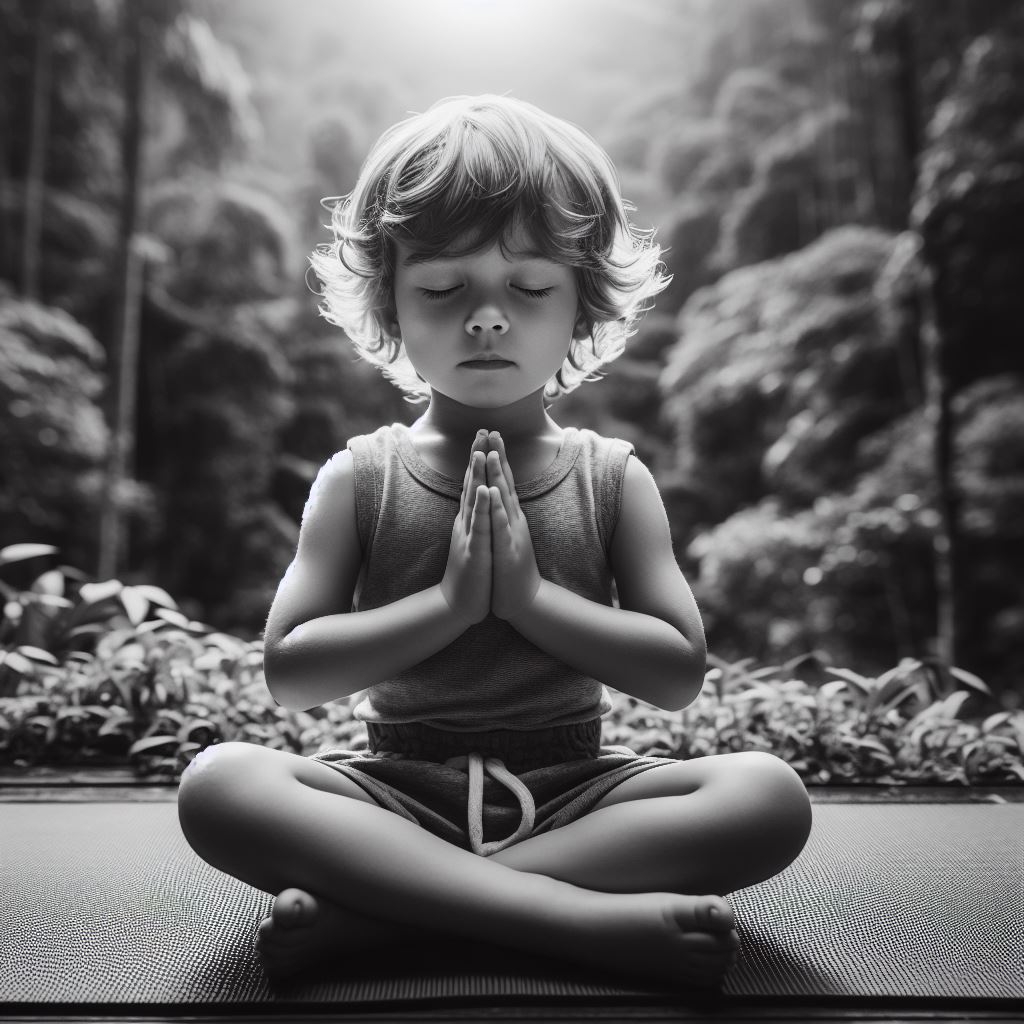
Table of Contents
In today’s fast-paced world, where distractions are constant, and stress levels are high, mindfulness has emerged as a beacon of peace and focus. Particularly for children, who are navigating the complexities of growing up, it becomes crucial to equip them with tools that foster mental well-being. This article delves into various techniques and activities that can help instill mindfulness in children, guiding them towards inner peace and enhanced focus.
Understanding Mindfulness in the Context of a Child
Mindfulness, at its core, is the practice of being fully present and engaged in the moment, aware of our thoughts and feelings without distraction or judgment. For children, this means learning to pay attention to their current experience, whether it’s their emotions, the sensations in their bodies, or their surroundings, without being overwhelmed by them.
Why Mindfulness Matters for Children
The benefits of mindfulness for children are profound and far-reaching. Studies have shown that mindfulness can improve mental health, enhance academic performance, and boost emotional regulation. It teaches children to approach situations with patience and calmness, reduces anxiety, and helps them develop a greater capacity for empathy and understanding.
Techniques to Foster Mindfulness in Children
- Breathing Exercises: One of the simplest yet most effective ways to bring a child into a state of mindfulness is through breathing exercises. Teach them to take slow, deep breaths, focusing on the sensation of air entering and leaving their body. This practice helps calm the mind and brings the child’s attention back to the present.
- Mindful Listening: Encourage children to engage in mindful listening. This can be done by asking them to close their eyes and identify various sounds in their environment. This activity not only sharpens their auditory senses but also teaches them to focus on the present.
- Body Scan Meditation: Guide children through a body scan meditation where they focus on each part of their body, noticing any sensations, tension, or relaxation. This technique helps children become more aware of their bodily sensations and develop a sense of connection with their physical selves.
- Mindful Coloring and Drawing: Mindful coloring and drawing are activities that can anchor children in the present moment. By concentrating on colors and shapes, children can express their creativity while practicing mindfulness.
Activities to Enhance Focus and Inner Peace in Children
- Nature Walks: Organize nature walks where children can explore their environment. Encourage them to notice the colors of the leaves, the patterns on the bark, the feel of the wind. This not only develops their observational skills but also deepens their connection to the natural world.
- Yoga for Kids: Yoga is an excellent way for children to practice mindfulness. It combines physical activity with breathing and focus, helping children develop coordination, balance, and concentration.
- Storytelling and Mindful Reading: Introduce children to stories and books that incorporate mindfulness concepts. Discuss the characters’ feelings and actions, encouraging children to empathize and reflect on their own experiences.
- Gratitude Journaling: Encourage children to maintain a gratitude journal where they can write about things they are thankful for each day. This practice fosters positivity and helps them appreciate the present.
Creating a Mindful Environment at Home and School
Parents and educators play a crucial role in fostering a mindful environment. This involves being present with the child, actively listening to them, and practicing mindfulness together. Creating a routine that includes mindfulness activities can help integrate these practices into a child’s daily life.
Incorporating mindfulness into the lives of children is not just about teaching them a set of techniques; it’s about guiding them towards a way of being that enhances their overall well-being. By teaching children mindfulness, we empower them with tools to navigate their emotions and thoughts, leading to a balanced and focused life.
As we conclude this first part of our exploration into mindfulness for children, we recognize the transformative impact these practices can have on a child’s life. In the next part, we will delve deeper into advanced mindfulness techniques and how to sustain these practices over time.

In the first part of this article, we explored the basic techniques and activities to introduce mindfulness to children. Now, let’s delve into more advanced techniques and strategies to sustain and deepen these practices, ensuring that mindfulness becomes a part of a child’s daily life, contributing significantly to their personal development and well-being.
Advanced Mindfulness Techniques for Children
- Guided Visualization: This technique involves guiding children through a mental imagery process, helping them visualize a calming scene or a happy memory. This exercise not only enhances their imagination but also serves as a tool for relaxation and stress reduction.
- Mindful Movement: Activities like tai chi or gentle stretching exercises can be integrated into mindfulness practice. These movements require concentration and awareness of the body, helping children stay anchored in the present moment.
- Emotional Awareness Exercises: Teaching children to identify and articulate their emotions is a crucial aspect of mindfulness. Activities like emotion wheel charts or feeling cards can help children understand and express their emotions more clearly.
- Mindfulness Bells: Using a bell or a chime periodically throughout the day can be a great reminder for children to pause and bring their focus back to the present. This simple technique can help reinforce the habit of mindfulness.
Sustaining Mindfulness Practices in Children
- Routine Integration: Incorporating mindfulness into the daily routine is essential. Whether it’s a few minutes of breathing exercises in the morning or a mindful walk after school, having a consistent schedule helps in making mindfulness a habit.
- Mindful Parenting and Teaching: Children learn by example. When parents and teachers practice mindfulness themselves, it encourages children to engage in these practices. Mindful communication, active listening, and presence are key components here.
- Mindfulness Apps and Online Resources: There are several child-friendly mindfulness apps and online resources available that offer guided meditations, mindfulness games, and exercises. These can be effective tools in making mindfulness both accessible and enjoyable for children.
- Mindfulness Groups and Clubs: Schools or communities can establish mindfulness clubs or groups where children can practice mindfulness together. This not only helps sustain the practice but also fosters a sense of community and shared learning.
Overcoming Challenges in Mindfulness Practice
It’s important to recognize that children may face challenges in maintaining a mindfulness practice. Distractions, lack of interest, or difficulty in understanding the concepts are common. To overcome these challenges, it’s crucial to keep the activities fun, relatable, and age-appropriate. Regular encouragement and celebrating small milestones can also help in keeping them motivated.
Long-Term Benefits of Mindfulness in Children
The long-term benefits of mindfulness in children are immense. Apart from immediate effects like improved focus and reduced stress, mindfulness lays the foundation for emotional intelligence, resilience, and empathy in later life. It equips children with skills to manage stress, navigate complex emotions, and make thoughtful decisions.
As we wrap up this comprehensive guide on mindfulness for children, it is clear that the journey of mindfulness is not just beneficial but transformative for a child’s mental, emotional, and physical well-being. From simple breathing exercises to more advanced techniques like guided visualization and emotional awareness exercises, mindfulness offers a range of practices suitable for children of all ages. The key is to make these practices a regular and enjoyable part of their life, ensuring they reap the long-term benefits of a mindful existence.
Mindfulness in children paves the way for a generation that is more aware, compassionate, and balanced. By investing in these practices, we are not only enhancing the lives of individual children but are also contributing to a more mindful and empathetic society.

FAQ: The Mindful Child – Techniques and Activities to Teach Kids Inner Peace and Focus
1. What is Mindfulness and How Does it Benefit Children?
Mindfulness is the practice of being fully present and aware of our surroundings and inner experiences without judgment. In children, mindfulness can foster emotional regulation, enhance focus, and develop empathy. It involves teaching kids to be aware of their thoughts, feelings, and bodily sensations in the present moment.
- Mindfulness is about being fully present and aware.
- It helps children regulate their emotions and enhance focus.
- Mindfulness develops empathy in kids.
2. At What Age Can Children Start Practicing Mindfulness?
Children can start practicing mindfulness at a very young age, even as toddlers. However, the techniques and activities should be age-appropriate. For younger children, mindfulness can be introduced through simple breathing exercises and sensory activities. As they grow older, more structured practices like guided meditations can be introduced.
- Start mindfulness with toddlers using simple techniques.
- Use age-appropriate activities for different age groups.
- Introduce more structured practices as children grow older.
3. What Are Some Effective Mindfulness Activities for Children?
Effective mindfulness activities for children include breathing exercises, mindful listening, body scans, and nature walks. These activities are designed to be engaging and suitable for young minds. They help children learn to focus on the present moment, recognize their emotions, and develop a deeper connection with their environment.
- Breathing exercises help with emotional regulation.
- Mindful listening enhances focus and awareness.
- Nature walks connect children with their environment.
4. How Can Parents and Educators Implement Mindfulness in Daily Routines?
Parents and educators can implement mindfulness in daily routines by incorporating short, regular mindfulness exercises throughout the day. This could be a few minutes of deep breathing before starting schoolwork, mindful eating during meals, or a body scan before bedtime. The key is consistency and making mindfulness a natural part of the day.
- Incorporate short mindfulness exercises throughout the day.
- Practice mindfulness during routine activities like eating.
- Consistency is key in making mindfulness a habit.
5. How Do You Measure the Success of Mindfulness Practices in Children?
The success of mindfulness practices in children can be measured through observable changes in behavior and self-reports. Parents and educators might notice increased calmness, improved focus, and better emotional regulation in children. Additionally, asking children about their feelings and experiences during mindfulness practices can provide insights into their progress.
- Observe changes in behavior and focus.
- Notice improvements in emotional regulation.
- Seek feedback from children about their mindfulness experiences.




